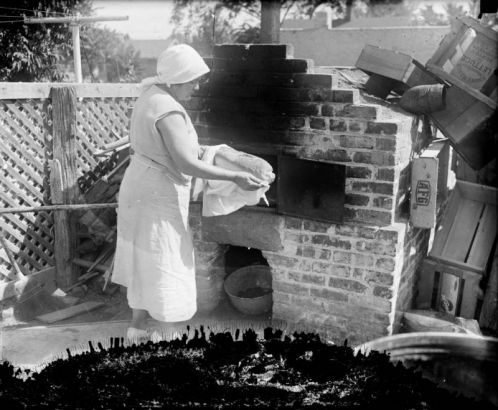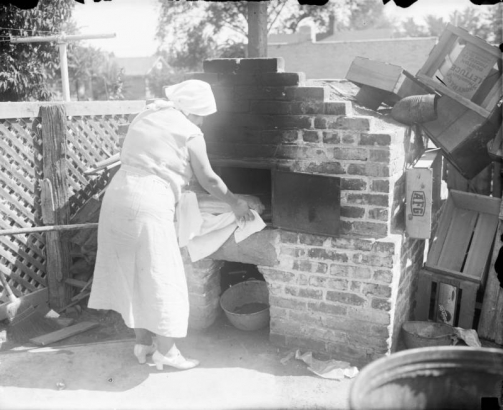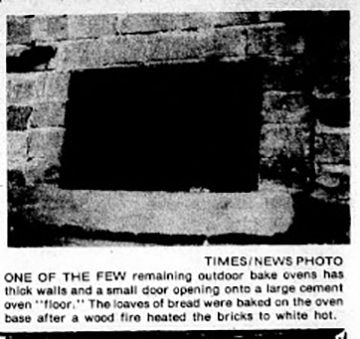North Denver's backyards were once more suited to bread than barbecue.
The Northside (an area of Denver that includes the neighborhoods of Highlands, Sunnyside, and Jefferson Park) was once home to a vibrant community of Italian Americans. In the interest of feeding one's family inexpensively—while keeping traditions of Italian bread making alive—some Northsiders baked bread in brick backyard ovens.
Italian immigrants were drawn to an area centered on Navajo, Osage, and Pecos Streets....The air was filled with the scent of bread baking in outdoor dome ovens.
–Northwest Denver by Mark A. Barnhouse (Arcadia Publishing: 2012)
Although a handful of books housed in the Western History and Genealogy department (WHG) reference these ovens, few photographs in the collection do. Fortunately, History Colorado has collected photographs of the outdoor ovens, acquired through its Italian American community documentation project, which launched in 2002. The project resulted in the largest Italian American research archive in the West, as well as History Colorado's publication of Italy in Colorado: Family Histories from Denver and Beyond by Alisa DiGiacomo in 2008.
That same History Colorado documentation project yielded several oral history interviews with Denver's Italian Americans. In a 2004 interview, Fred Sabell described his mother's outdoor oven in Sunnyside:
"...she had an oven outside—an outside oven and it was huge! It was almost as big as my living room and she would put dough in there and make bread and even had one of those things you push to get like ten loaves of bread in there, so she'd sell bread to the neighbors. ...I think the bread was a quarter."
It wasn't uncommon for women to sell their extra bread. A typical oven—constructed of brick with a rounded, beehive-like roof covered in cement or stucco—was usually large enough to bake between ten and twelve loaves at a time.
Louisville resident Lena (Polluconi) Ingram had a 16-loaf forno (Italian for "oven"), which she used to bake bread for the Colacci grocery store. It was a way to support her family after her husband, Martin Polluconi, was killed in a Matchless Mine accident in 1929.
Mrs. Ingram’s recipe began with 50 pounds of flour (she used Hungarian flour), the salt added to the flour, potato water made from boiled potatoes that were strained, and yeast foam which she "started” the night before. The ingredients were mixed together, the 16 large loaves where shaped, sometimes into rounds and sometimes long loaves, the fire fed until the bricks were white hot, and the oven cleaned with a broom which had been made of corn shucks. The loaves baked in about 35 to 40 minutes, and were judged baked when they had reached the proper shade of brown.
–"Outdoor Ovens Here Abandoned: Progress Ends Old World Baking Tradition" by Carolyn Connaroe, Louisville Times, May 12, 1977
Towards the latter part of the 20th century, the outdoor ovens fell out of favor as people moved, supermarkets proliferated, and cultures changed. Given the ovens' backyard locations, it is hard to know how many ovens—if any—survive today in North Denver.
Just which homes had outdoor ovens? Unfortunately, this information was not recorded on Sanborn Fire Insurance maps, which—as the Library of Congress puts it—"show the size, shape and construction materials of dwellings, commercial buildings, factories and other structures."
For now, photographs, newspaper articles, and oral history interviews provide the most information about the history of this phenomenon.
Do you have a bread oven in your yard? Or, do you remember seeing outdoor ovens in Denver? We'd love to hear from you! Please comment below.





Comments
I lived at 2331 Bryant St.
I lived at 2331 Bryant St. there was a fire pit/oven that we used to burn trash in the 50’s and 60’s. I don’t know if it was ever used to back bread, but I remember it always looked like a little kitchen. Time for some research. Love this article! Thank you
Thanks for reading and
Thanks for reading and commenting, Jan! Please update us on what you find in our research.
My great grandma Rose Loseno
My great grandma Rose Loseno at 35th &Mariposa had a big oven the whole family would be there every Sunday. The best was a bowl of sauce with a piece of her bread to mop it up. The kids would play men played cards women would visit. After dinner the accordion came out the neighbors came over to sing Italian songs,what fun we had!
There might be one at a house
There might be one at a house on the northwest corner of 49th and Knox, a bit further north than the neighborhood you're talking about, but possible? I've noticed it a few times and wondered about it!
We're at 42nd & Clay and have
We're at 42nd & Clay and have an oven out back. It's in a pretty good state of disrepair but I always thought it was just an old backyard trash incinerator - so never thought much about it or doing anything with it. I wonder if it could have been a bread oven. Were there any characteristics that might distinguish a bread oven from an incinerator? I might have to do a little masonry restoration on it this summer!
Hi Rod,
Hi Rod,
Here's a physical description of the ovens from "Outdoor Ovens Here Abandoned: Progress Ends Old World Baking Tradition" by Carolyn Connaroe, Louisville Times, May 12, 1977:
We had a brick incinerator at
We had a brick incinerator at the back of our property, it was faux brick. It looked like a small chimney but only about 4 feet high, no beehive shape. 36th and Irving. What a great story!
There are several photos of
There are several photos of the Colacci kitchen in Louisville in the Public Service Company of Colorado collection, WH1367, when they used coal in their ovens and after they converted to natural gas fuel.
Great article Katie - as usual - we appreciate your contributions.
Add new comment